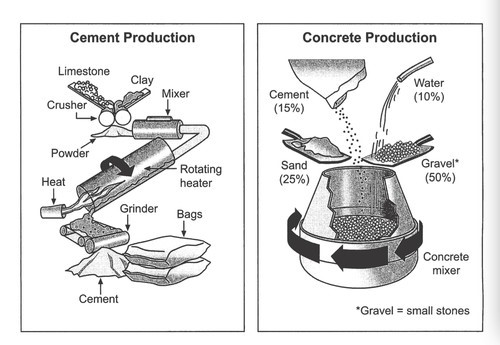Cam 8 Test 3 Writing Task 1
Summarise the information by selecting and reporting the main features, and make comparisons where relevant.

1. Phân tích biểu đồ
– Process loại thứ nhất: “Miêu tả cái gì được làm như thế nào?” hay còn gọi là dạng man-made process.
– Đây là process nói về các bước sản xuất xi măng và bê tông, trông có vẻ “nguy hiểm” nhưng thực ra phân tích cũng không có gì cả. Với dạng process mình phải đưa hết tất cả các bước (không chừa bước nào) nên không phải chọn những đặc điểm chung, mà chỉ đơn giản là thấy gì viết nấy.
Cấu trúc bài viết
– Introduction: Paraphase lại đầu bài bằng 1 câu đơn giản
– Overview: Nêu tổng quát số bước sản xuất, các cách sản xuất. Nêu tên bước đầu tiên và thành quả cuối cùng.
– Body:
- Body 1: Mô tả chi tiết, lần lượt từng bước (có gì nói đấy) các công đoạn làm xi măng.
- Body 2: Mô tả cách dùng xi măng tạo ra bê tông.
2. Bài mẫu tham khảo
Bài mẫu tham khảo số 1:
The two diagrams illustrate the processes involved in the production of cement and concrete.
It is evident that cement production consists of five stages, starting with the crushing of limestone and clay and concluding with packaging, whereas concrete production is a more straightforward process involving just two main steps.
In the first process, limestone and clay are initially fed into a crusher, which reduces them to a fine powder. This powder is then transferred into a mixer, where the ingredients are thoroughly blended. Next, the mixture undergoes a heating process in a rotating kiln at high temperatures, followed by grinding to produce the final cement product. The cement is then packaged into bags for storage and distribution.
In contrast, concrete production is less complex. Cement, along with other materials such as gravel, sand, and water, is carefully measured in specific proportions—15%, 50%, 25%, and 10%, respectively. These materials are subsequently combined in a rotating mixer to form concrete, which is ready for use in construction.
Written by IELTS Thanh Loan
Bài mẫu tham khảo số 2:
The first diagram illustrates the process of cement manufacture, and the second diagram shows the materials that go into the production of concrete.
It is clear that there are five stages in the production of cement, beginning with the input of raw materials and ending with bags of the finished product. To produce concrete, four different materials are mixed together.
At the first stage in the production of cement, limestone and clay are crushed to form a powder. This powder is then mixed before it passes into a rotating heater. After heating, the resulting mixture is ground, and cement is produced. Finally, the cement is packaged in large bags.
Cement is one of the four raw materials that are used in the production of concrete, along with gravel, sand and water. To be exact, concrete consists of 50% gravel, 25% sand, 15% cement and 10% water. All four materials are blended together in a rotating machine called a concrete mixer.
Written by ielts-simon.com
Bạn đang chuẩn bị cho kì thi IELTS?
Học IELTS Online qua ZOOM, bức band thần tốc
IELTS Thanh Loan – giáo viên 10 năm kinh nghiệm – trực tiếp đứng lớp, tự tin mang đến khóa học chất lượng nhất, phương pháp giảng dạy cô đọng dễ hiểu, giáo trình tự biên soạn cho lộ trình từ cơ bản đến luyện đề chuyên sâu. Đặc biệt, học viên luôn được quan tâm sát sao nhất, hỗ trợ không giới hạn, thúc đẩy kỷ luật học tập tốt để đạt mục tiêu.

3. Từ vựng
- Straightforward (adjective): /ˌstreɪtˈfɔːwəd/ đơn giản, dễ hiểu
English meaning: easy to understand or do; uncomplicated. - Be fed into (verb phrase): /biː fɛd ˈɪntuː/ được cho vào, được đưa vào
English meaning: to be introduced or inserted into a system, machine, or process. - Subsequently (adverb): /ˈsʌbsɪkwəntli/ sau đó, tiếp theo
English meaning: after a particular thing has happened; following in time or order.
4. Lược dịch
Bài mẫu tham khảo số 1:
Hai sơ đồ mô tả các quá trình xi măng và bê tông.
Rõ ràng việc sản xuất xi măng bao gồm năm bước, bắt đầu bằng việc nghiền đá vôi và đất sét và kết thúc bằng đóng gói bao bì, trong khi việc sản xuất bê tông chỉ có hai bước.
Nhìn vào quá trình sản xuất xi măng, ban đầu đá vôi và đất sét được đặt qua một máy nghiền để nghiền thành bột. Tiếp theo, bột sau đó được đổ vào một máy trộn, nơi các thành phần được pha trộn. Sau đó, sản phẩm thu được được chuyển qua lò quay ở nhiệt độ cao, tiếp theo là quá trình nghiền để tạo ra xi măng và cuối cùng được đóng gói vào túi để lưu trữ và phân phối.
Về quy trình tạo bê tông, xi măng và các vật liệu khác bao gồm sỏi, cát và nước được chuẩn bị theo tỷ lệ thích hợp, tương ứng là 15%, 50%, 25% và 10%. Sau đó, tất cả chúng đều được đổ vào máy trộn quay để tạo thành bê tông cho mục đích xây dựng.
Bài mẫu tham khảo số 2:
Sơ đồ đầu tiên minh họa quy trình sản xuất xi măng và sơ đồ thứ hai cho thấy các vật liệu đi vào sản xuất bê tông.
Rõ ràng là có năm công đoạn trong quá trình sản xuất xi măng, bắt đầu từ đầu vào của nguyên liệu thô và kết thúc với bao thành phẩm. Để sản xuất bê tông, bốn loại vật liệu khác nhau được trộn với nhau.
Ở giai đoạn đầu tiên trong quá trình sản xuất xi măng, đá vôi và đất sét được nghiền nhỏ để tạo thành bột. Bột này sau đó được trộn trước khi đưa vào lò quay. Sau khi đun nóng, hỗn hợp thu được được nghiền và tạo ra xi măng. Cuối cùng, xi măng được đóng gói trong các bao lớn.
Xi măng là một trong bốn nguyên liệu thô được sử dụng để sản xuất bê tông, cùng với sỏi, cát và nước. Chính xác thì bê tông bao gồm 50% sỏi, 25% cát, 15% xi măng và 10% nước. Tất cả bốn nguyên liệu được trộn với nhau trong một máy quay được gọi là máy trộn bê tông.
[stu alias=”khoa_truy_cap_cac_bai_giai_de”]Xem thêm:
- Bài mẫu Writing Task 1 & 2 Cam 8 Test 1
- Bài mẫu Writing Task 1 & 2 Cam 8 Test 2
- Bài mẫu Writing Task 1 & 2 Cam 8 Test 3
- Bài mẫu Writing Task 1 & 2 Cam 8 Test 4
Đừng bỏ qua những cuốn sách cực hữu ích:
Cam 8 Test 3 Writing Task 2
Increasing the price of petrol is the best way to solve growing traffic and pollution problems. To what extent do you agree or disagree? What other measures do you think might be effective?
1. Phân tích câu hỏi
There are two questions to answer:
- Do you think increasing the price of petrol is the best way to solve growing traffic and pollution problems?
- What other measures do you think might be effective to solve traffic and pollution problems?
Increasing the price of petrol:
- if the price is increased, less people will be able to afford it
- if fewer people can afford petrol, fewer people will drive cars
- if fewer people drive cars, there will be less congestion on the roads
- if fewer people drive, there will be less air pollution
Other ways to solve traffic and pollution problems:
- traffic problems can be solved by improving public transport to encourage more people to use it rather than to use their own cars
- public transport can be improved by having more public transport available, making it more punctual and reducing the price of tickets to make it more affordable to the average person
- another measure is to have no traffic zones in city centers which will reduce both congestion and pollution in urban centers.
2. Bài mẫu tham khảo
There is no doubt that traffic and pollution from vehicles have become huge problems both in cities and on motorways everywhere. Solving these problems is likely to need more than a simple rise in the price of petrol.
While it is undeniable that private car use is one of the main causes of the increase in traffic and pollution, higher fuel costs are unlikely to limit the number of drivers for long. As this policy would also affect the cost of public transport, it would be very unpopular with everyone who needs to travel on the roads. But there are various other measures that could be implemented that would have a huge effect on these problems.
I think to tackle the problem of pollution, cleaner fuels need to be developed. The technology is already available to produce electric cars that would be both quieter and cleaner to use. Persuading manufaturers and travellers to adopt this new technology would be a more effective strategy for improving air quality, especially in cities.
However, traffic congestion will not be solved by changing the type of private vehicle people can use. To do this, we need to improve the choice of public transport services available to travellers. For example, if sufficient sky trains and underground train systems were built and effectively maintained in our major cities, then traffic on the roads would be dramatically reduced. Long-distance train and coach services should be made attractive and affordable alternatives to driving your own car for long journeys.
In conclusion, I think that long-term traffic and pollution reductions would depend on educating the public to use public transport more, and on governments using public money to construct and run efficient systems.
From IELTS Cambridge 8
3. Từ vựng
- Undeniable (adjective): /ˌʌndɪˈnaɪəbl/ không thể chối cãi được
English meaning: impossible to deny or dispute; certain and clear. - Implement (verb): /ˈɪmplɪˌmɛnt/ thực hành, thực thi
English meaning: to put into effect or carry out a plan, decision, or system. - Adopt (verb): /əˈdɒpt/ áp dụng, chọn lựa
English meaning: to take up or start to use something, such as a method, idea, or policy. - Sufficient (adjective): /səˈfɪʃənt/ đủ
English meaning: adequate amount or quantity; enough for a particular purpose. - Affordable (adjective): /əˈfɔːdəbəl/ trong khả năng chi trả
English meaning: reasonably priced; within one’s financial means.
Tự học IELTS tại nhà chỉ từ 1.2 triệu?
Bằng Khóa học IELTS Online dạng video bài giảng
Giải pháp tự học IELTS tại nhà, tiết kiệm chi phí, linh hoạt thời gian nhưng đảm bảo hiệu quả. Khóa học dạng video bài giảng có lộ trình học từng ngày chi tiết. Học viên học lý thuyết qua video bài giảng, thực hành Listening Reading trực tiếp trên website, còn Writing Speaking được chấm chữa trực tiếp bởi cô Thanh Loan. Mọi bài giảng đều có tài liệu học tập đi kèm.

4. Dịch tiếng Việt
Không còn nghi ngờ gì nữa, giao thông và ô nhiễm từ các phương tiện giao thông đã trở thành những vấn đề lớn cả ở các thành phố và đường dành cho ô tô ở khắp mọi nơi. Để giải quyết những vấn đề này thì có lẽ ngoài việc tăng giá xăng dầu đơn thuần, chúng ta cần làm nhiều việc hơn.
Mặc dù không thể phủ nhận rằng việc sử dụng ô tô cá nhân là một trong những nguyên nhân chính của sự gia tăng giao thông và ô nhiễm, nhưng chi phí nhiên liệu cao hơn khó có thể hạn chế số lượng tài xế trong thời gian dài. Vì chính sách này cũng sẽ ảnh hưởng đến chi phí giao thông công cộng, nên giao thông công cộng sẽ không được ưa chuộng đối với tất cả những người có nhu cầu đi lại trên đường. Nhưng có nhiều biện pháp khác có thể được thực hiện sẽ có tác dụng rất lớn đối với vấn đề này.
Tôi nghĩ để giải quyết vấn đề ô nhiễm, cần phải phát triển nhiên liệu sạch hơn. Công nghệ này đã có sẵn để sản xuất ô tô điện vừa êm hơn vừa sạch hơn khi sử dụng. Thuyết phục các nhà sản xuất và hành khách áp dụng công nghệ mới này sẽ là một chiến lược hiệu quả hơn để cải thiện chất lượng không khí, đặc biệt là ở các thành phố.
Tuy nhiên, tình trạng ùn tắc giao thông sẽ không được giải quyết bằng cách thay đổi loại phương tiện cá nhân mà người dân có thể sử dụng. Để làm được điều này, chúng ta cần cải thiện sự lựa chọn của các dịch vụ giao thông công cộng dành cho du khách. Ví dụ, nếu có đủ hệ thống tàu điện trên không và tàu điện ngầm được xây dựng và duy trì hiệu quả ở các thành phố lớn của chúng ta, thì giao thông trên đường bộ sẽ giảm đáng kể. Dịch vụ xe lửa và xe khách đường dài nên là lựa chọn thay thế hấp dẫn và hợp túi tiền cho việc tự lái ô tô của bạn trong những chuyến đi dài.
Tóm lại, tôi nghĩ rằng việc giảm thiểu ô nhiễm và giao thông trong dài hạn sẽ phụ thuộc vào việc giáo dục công chúng sử dụng phương tiện giao thông công cộng nhiều hơn và các chính phủ sử dụng tiền công để xây dựng và vận hành các hệ thống hiệu quả.
[/stu]Mời bạn cùng tham gia cộng đồng “Học IELTS 0đ” trên Zalo cùng IELTS Thanh Loan, nhận những video bài giảng, tài liệu, dự đoán đề thi IELTS miễn phí và cập nhật













